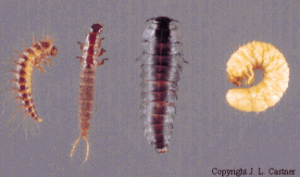 The larvae shown here are from four different beetle families, and are representation of the body types that can be found in each of the respective families. The families are (from left to right) Dermestidae, Staphylinidae, Silphidae, Scarabaeidae. Larvae such as these are typically found later in the stages of insect succession, after the early arriving flies. The Dermestids are commonly called skin beetles and their larvae are commonly used in museums to clean bones of their associated tissues. Staphylinds (commonly called rove beetles) and Silphids (called carrion, sexton, or burying beetles) are both predaceous on maggots. Of lesser forensic importance is the Scarabs. Their larvae are commonly found on carcasses in the late stages of decay. While some species can be useful in making entomological based time since colonization intervals which can relate to a postmortem interval, detailed developmental data is lacking for many species.
The larvae shown here are from four different beetle families, and are representation of the body types that can be found in each of the respective families. The families are (from left to right) Dermestidae, Staphylinidae, Silphidae, Scarabaeidae. Larvae such as these are typically found later in the stages of insect succession, after the early arriving flies. The Dermestids are commonly called skin beetles and their larvae are commonly used in museums to clean bones of their associated tissues. Staphylinds (commonly called rove beetles) and Silphids (called carrion, sexton, or burying beetles) are both predaceous on maggots. Of lesser forensic importance is the Scarabs. Their larvae are commonly found on carcasses in the late stages of decay. While some species can be useful in making entomological based time since colonization intervals which can relate to a postmortem interval, detailed developmental data is lacking for many species.
Dr. J. H. Byrd
Copyright © 1998-2018
All rights reserved.